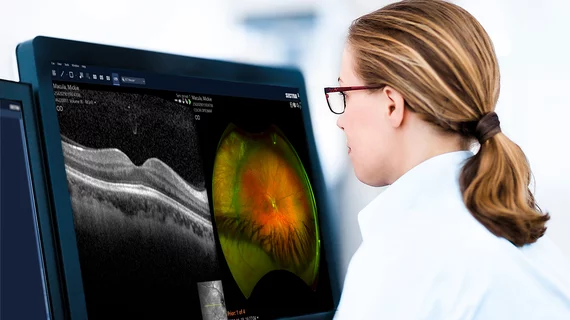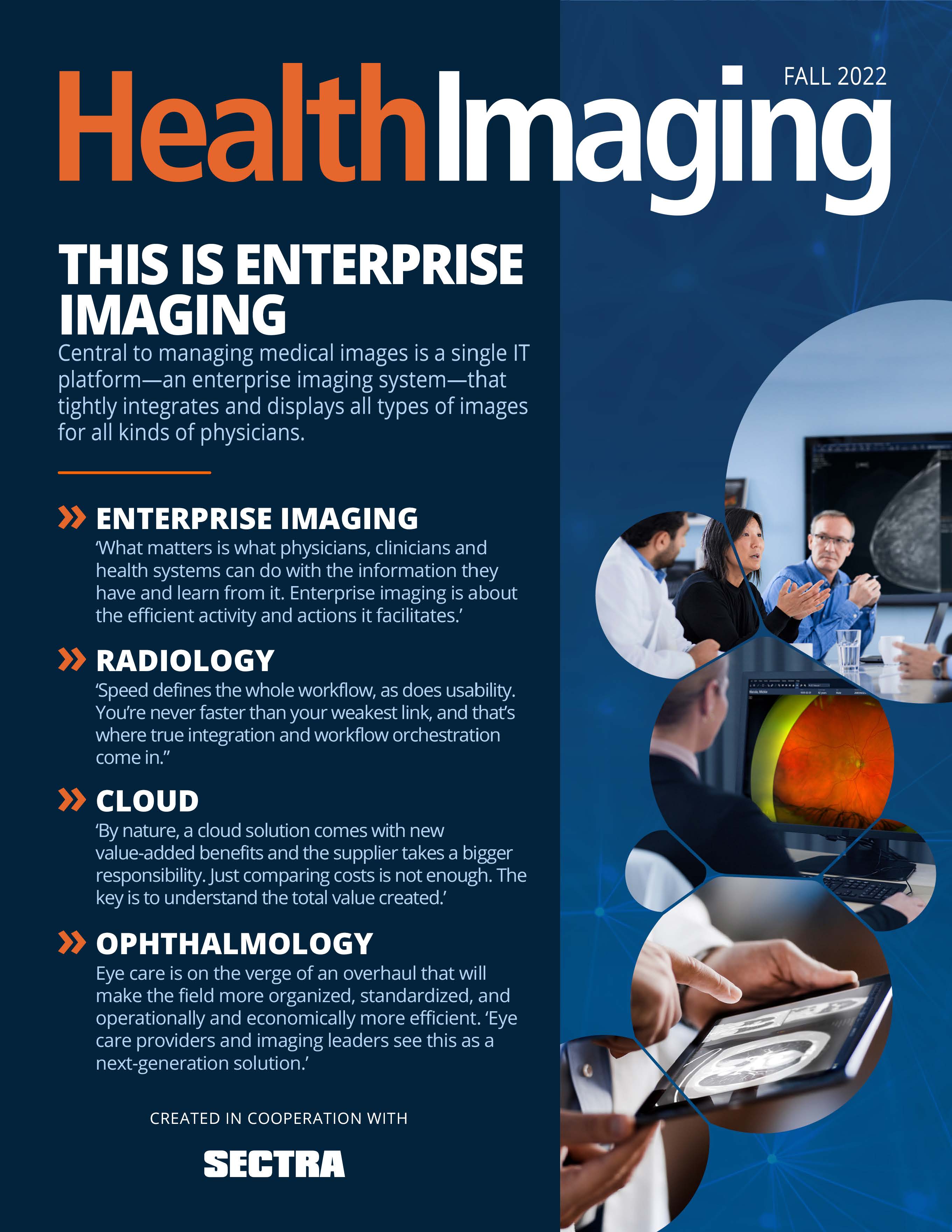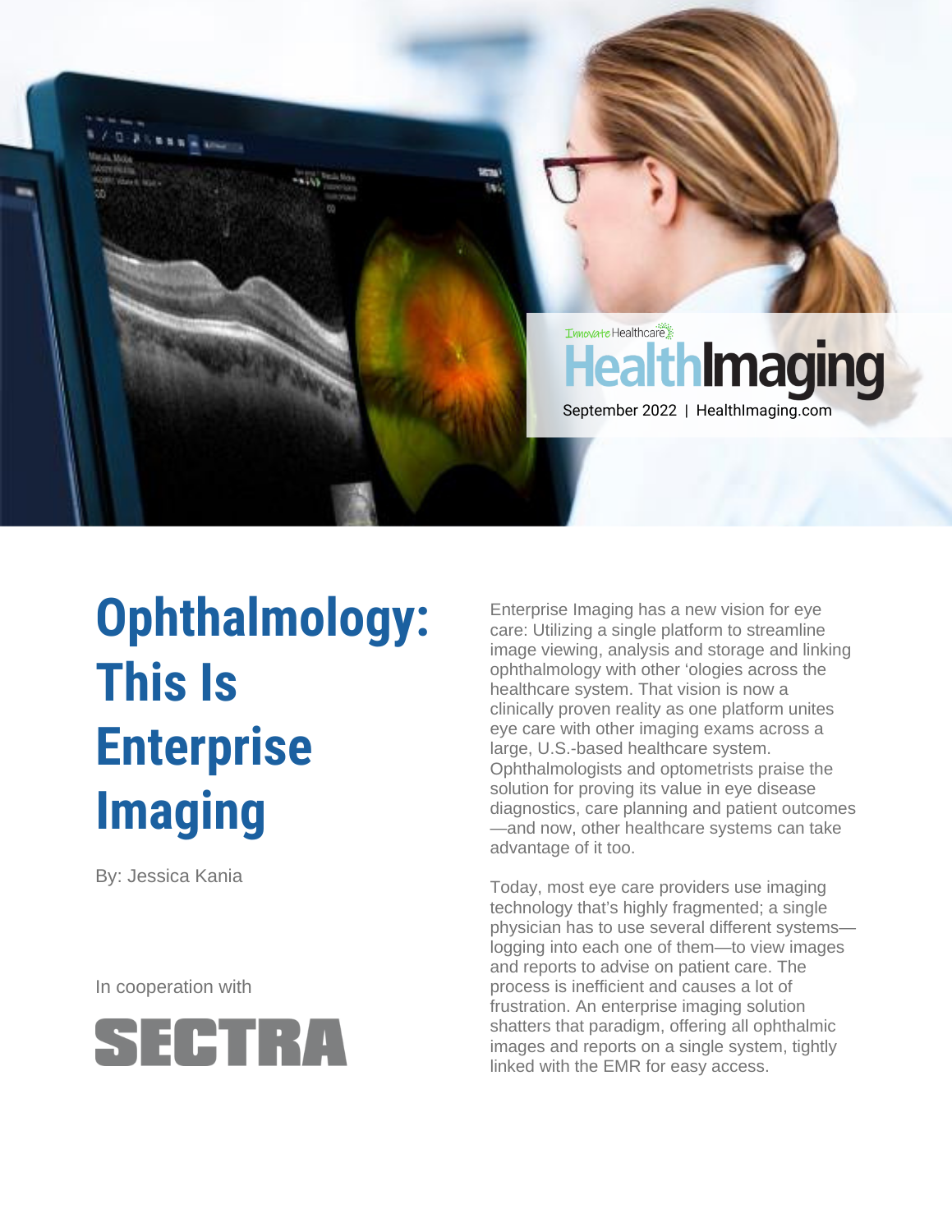Ophthalmology: This Is Enterprise Imaging
Enterprise Imaging has a new vision for eye care: Utilizing a single platform to streamline image viewing, analysis and storage and linking ophthalmology with other ‘ologies across the healthcare system. That vision is now a clinically proven reality as one platform unites eye care with other imaging exams across a large, U.S.-based healthcare system. Ophthalmologists and optometrists praise the solution for proving its value in eye disease diagnostics, care planning and patient outcomes—and now other healthcare systems can take advantage of it too.
Today, most eye care providers use imaging technology that’s highly fragmented; a single physician has to use several different systems—logging into each one of them—to view images and reports to advise on patient care. The process is inefficient and causes a lot of frustration. An enterprise imaging solution shatters that paradigm, offering all ophthalmic images and reports on a single system, tightly linked with the EMR for easy access.
“When it comes to standardization, ophthalmology is where radiology was 20 years ago,” says Pontus Svärd, Sectra’s global product manager for ophthalmology. “Most eye care providers are operating in a practice where each imaging modality vendor provides their own storage and viewing software, sometimes even storing data in proprietary formats. It all adds up, resulting in a multitude of isolated applications for reviewing all the different types of information. There’s so much room for consolidation.”
Lessons learned from radiology, cardiology and other image-rich specialties show that physicians were wasting a lot of time working across multiple workstations. They were at a disadvantage when they couldn’t access changes in images and data, side by side, over time and confer on images and data with colleagues in an efficient way.
Why has ophthalmology been overlooked for so long when it comes to modern IT architecture? Partly because eye care is more of a “one-stop shop,” Svärd notes, where the same department or clinic is responsible for seeing the patient, performing various imaging studies, interpreting the result, and then planning and executing treatment.
But being separate is no advantage and that’s why one of the largest U.S. healthcare systems approached Sectra when they needed a new eye care imaging and data management system. The healthcare system was facing end-of-life with its ophthalmic imaging solution. They found the maturity and scalability of the Sectra Enterprise Imaging platform appealing but also recognized a need for strengthening the ophthalmology specific capabilities. Guided by their key clinical users, Sectra managed to close this gap. Today that healthcare organization uses Sectra’s Enterprise Imaging solution to manage 1.8 million eye care studies per year.
This momentum is stirring an evolution. As a result of enterprise imaging, ophthalmic imaging is on the verge of an overhaul that will make the field more organized, standardized, and operationally and economically more efficient.
Tools for easy image review
“Our enterprise imaging solution contains more than just image storage and sharing,” Svärd says. “It also includes a diagnostic application with operational tools and functions that allow for easy comparison and analysis of images, helping ophthalmologists do their jobs better and faster. And it’s scalable for offices, departments and healthcare systems.”
Here are some of the most utilized tools and features for common ophthalmic imaging modalities available in Sectra Ophthalmology Imaging:
- Optical coherence tomography (OCT). OCT scans are presented as a scrollable stack together with a smaller fundus image with reference lines for orientation. Retinal images also allow a higher axial resolution, making it easier for physicians to see and analyze the layers within the retina.
- Fundus photos. For fundus photos that capture color images of the retina, Sectra Ophthalmology Imaging offers various color adjustment options, including the ability to show individual color channels. Measurement tools make it easy to measure findings to calculate optic cup-to-optic disc ratios, prepare for photodynamic therapy and track lesions over time. Measurements performed in standard compliant ultra-widefield photos will compensate for the large distortion in the periphery caused by the large curvature of the retina.
- Visual field test. For visual field tests that look for weakened vision or blind spots across the entire retina, the ophthalmology module offers a tool to quickly assess a patient’s progression over time by quickly and easily moving through consecutive images from previous visits.
The diagnostic application also allows ophthalmologists to easily access MR and CT images along with viewing tools, rather than having to go to a separate workstation to view them. They also can view images from niche devices such as ultrasound and corneal topographers can utilize tools to review the output. For all modalities, the eye care provider may lock on the left or right eye to be sure they’re consistently focused on just one at a time.
Side-by-side comparison with a single sign-on
When an ophthalmologist wants to review images from two different modalities, Sectra Ophthalmology Imaging allows them to view the images side-by-side on one screen, all with a single sign-on. This is one of the features ophthalmologists have appreciated most: the ability to pull up all relevant images from all modalities in less time, and with fewer clicks.
“In many practices, the first thing an ophthalmologist will do in the morning is to start logging in to all of their different imaging applications,” Svärd says. “If they want to review two different types of studies, they’ll need to flip back and forth between different applications to review them. One enterprise platform and a single diagnostic application changes all of that.”

“The providers tell us that viewing prior and current images on the screen together and easily moving to an older comparison prior gives them a better understanding of disease progression or improvement. It also serves as an educational tool. Many of our users show images to patients directly, so that they can better grasp any changes in their own condition.”
Pontus Svärd, Sectra’s Global Product Manager for Ophthalmology
In addition to reducing complexity, working in a single application also can reduce the chances of human error, Svärd notes. During the time-consuming process of pulling up separate patient files in multiple systems, the chances that an ophthalmologist gets distracted and clicks on the wrong file is greater.
“When you're looking at five different applications with images and then an EMR, and nothing's tied together,” he says, “the risk that you're reporting or reviewing images of the wrong patient is really evident.”
A single diagnostic application also helps facilitate collaboration among physicians on complex cases and treatment plans. “When they’re in meetings together, instead of ‘alt-tabbing’ through a bunch of different applications, they have the images they want to discuss prepared in a suitable layout before they walk into the meeting room,” he says. “Bam, they're there, as soon as they open the case.”
Monitoring disease progression
In addition to viewing images from all modalities together, Sectra Ophthalmology Imaging also offers comparison views for images from the same modality, which allows eye care providers to easily evaluate change of disease and anatomy over time.
“The providers tell us that viewing prior and current images on the screen together and easily moving to an older comparison prior gives them a better understanding of disease progression or improvement,” Svärd says. “It also serves as an educational tool. Many of our users show images to patients directly, so that they can better grasp any changes in their own condition.”
Conformity to DICOM standards promotes shareability and coordination
All images are securely stored, easy to access, and comply with the Digital Imaging and Communications in Medicine (DICOM) standard—leading ophthalmology’s shift toward DICOM compliance for all imaging modalities.
The American Academy of Ophthalmology as well as the National Eye Institute are actively encouraging that trend, and both promote the benefits of standardizing digital imaging in eye care around established DICOM standards. Being interoperable across devices allows for more efficient patient care, simpler coordination of care and easier image sharing, as well as enabling the creation of comprehensive datasets for research and big data analyses and developing algorithms for machine learning and artificial intelligence. American Academy of Ophthalmology Leads Call for Ophthalmic Equipment Manufacturers to Standardize Digital Imaging - American Academy of Ophthalmology (aao.org)
The effort also is endorsed globally by the American Society of Retina Specialists, the Asia-Pacific Academy of Ophthalmology, the Royal College of Ophthalmologists, and the Royal Australian and New Zealand College of Ophthalmologists.
“Standardization has really kicked off in ophthalmology,” Svärd says. “It’s getting more and more difficult to sell modalities today without at least an option for DICOM support. Most healthcare system leaders are now demanding DICOM compliance when procuring new equipment.”

“We’ve put all of these ophthalmology tools into one platform—the same platform that we use for other imaging fields. So for our installed base, this means that you don’t need any additional infrastructure components. You just scale out your storage and server capacity to handle the additional volume, and you’re good to go. It’s the same client, it’s the same server platform, it’s just an extra piece of functionality.”
Fredrik Gustavsson, Sectra’s CTO
A single system for all departments
In addition to DICOM compliance and system consolidation for ophthalmic images, the Sectra Enterprise Imaging solution offers those options for all images across all departments—meaning that a single system can service an entire health network across multiple ‘ologies.
“We’ve put all of these ophthalmology tools into one platform—the same platform that we use for other imaging fields,” says Fredrik Gustavsson, Sectra’s CTO. “So for our installed base, this means that you don’t need any additional infrastructure components. You just scale out your storage and server capacity to handle the additional volume, and you’re good to go. It’s the same application, it’s the same server platform, it’s just an extra piece of functionality.”
Now that ophthalmology has been proven in everyday clinical practice, it’s also being rolled out to other healthcare systems and facilities. It’s a good fit for other large organizations looking to implement a comprehensive enterprise imaging solution that now includes ophthalmology. That’s because the ability to manage an entire organization’s imaging needs in one highly effective platform reduces complexity and costs.
Physician, technology and IT feedback has been very positive along the way. “The most common reactions I hear are ‘fast, intuitive and easy to use,’” Svärd says. “People are often pleasantly surprised at how well the setup goes, how quick it is to get started using the application, and how simple and intuitive it is.”
“Users tell us they appreciate reviewing progression studies and doing comparisons,” he adds. “One calls the coordinated zoom across all imaging studies ‘amazing.’ We appreciate that many physicians tell us their workdays flow more smoothly. They also say access to imaging and patient information is easier, with fewer steps and clicks.”
All of these are the advantages of Sectra Enterprise Imaging, a single platform that provides a holistic patient overview, and now includes ophthalmology imaging. As Svärd says: “Eye care providers and imaging leaders see this as the next-generation.”


